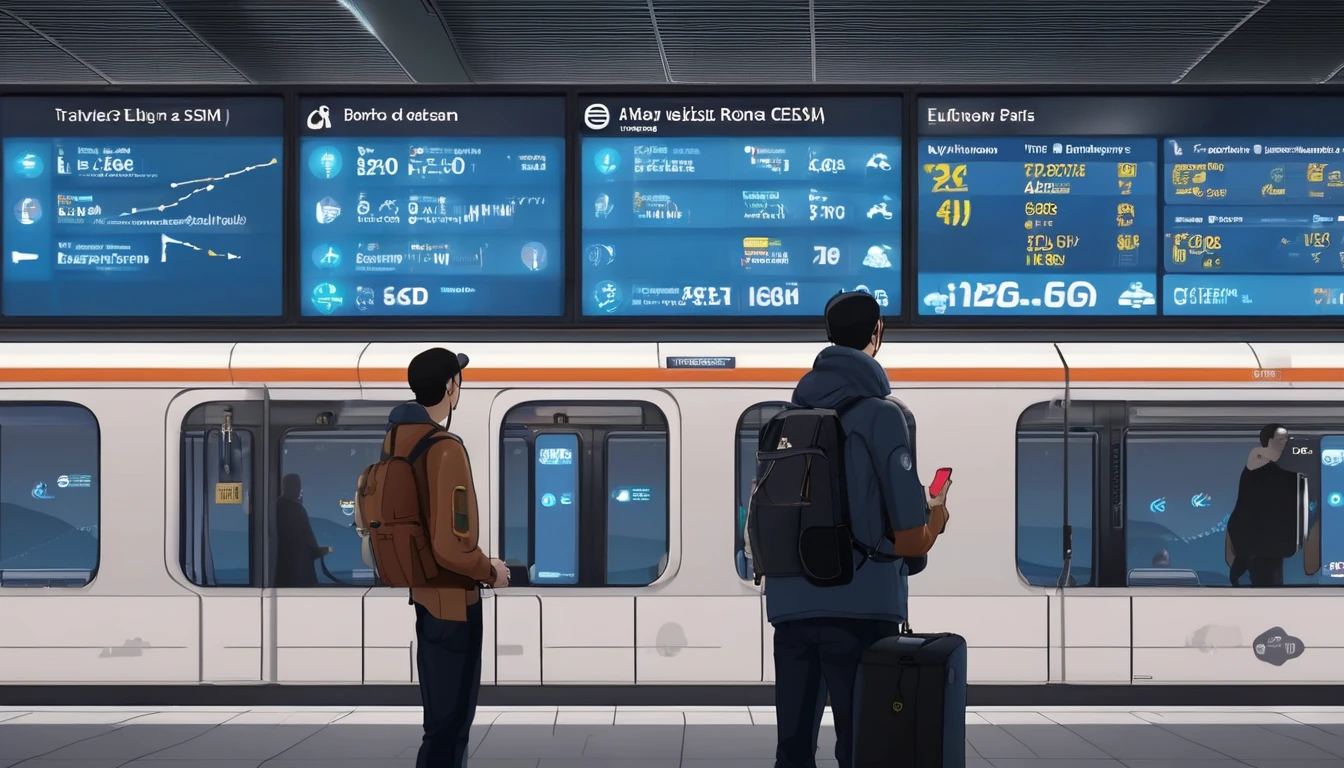Rome is dense, beautiful, and busy – which makes mobile data a moving target. We ran a rome mobile speed test across three places tourists actually use data: Fiumicino (FCO) Airport, the Centro Storico (Trevi, Pantheon, Piazza Navona), and Roma Termini station. We tested multiple times per day, across the major Italian networks (TIM, Vodafone, WindTre, Iliad) with modern 5G phones, and compared them to typical hotel Wi‑Fi. The short story: 5G beats most hotel Wi‑Fi, but crowds matter. Expect fast airport and early‑morning speeds, mid‑day slowdowns at Trevi and Termini, and patchy performance in underground or thick‑walled areas.
Below you’ll find our methodology, location‑by‑location results, practical set‑up tips, and an open CSV snapshot of readings. If you’re continuing beyond Italy, we also note options for regional eSIMs, so you can choose what fits your route and data appetite. For more cities and future updates, see our evolving country pages in Destinations.
Rome mobile speed test: how we measured
- Test window: late September, weekday and weekend, off‑peak (early morning) and peak (mid‑day/early evening).
- Devices: iPhone 15 and Pixel 8 Pro, 5G enabled, dual‑SIM capable.
- Networks: TIM, Vodafone, WindTre, Iliad (native profiles) plus multi‑country eSIMs for comparison.
- Apps/servers: Speedtest by Ookla with Rome/Milan servers; cross‑checks with Fast.com; 3 runs per spot per operator, median recorded.
- Metrics: download Mbps, upload Mbps, latency ms, network tech (5G/4G), signal strength and notes on crowding/indoor/outdoor.
- Locations:
- FCO Terminal 3 Arrivals, SkyTrain platform, Leonardo Express platform
- Centro Storico: Trevi Fountain, Pantheon, Piazza Navona
- Roma Termini: main concourse, platforms, metro hall, piazza outside
We kept phones in 5G Auto, disabled Low Data Mode, and ensured no background updates. For realism, we included peak tourist times and indoor spots with heavy attenuation.
Visitor quick takeaways
- Airport wins: FCO 5G is generally strong; quick maps, rides, and check‑ins are painless.
- Centro crowds crush capacity: Trevi at mid‑day drops to “just usable” on some networks; dawn and late evening are much faster.
- Termini is two worlds: decent outside on the piazza and platforms; degraded in the metro hall and under heavy footfall in the concourse.
- 5G beats hotel Wi‑Fi: mid‑range hotel Wi‑Fi in Centro often tested 10–30 Mbps with high latency; 5G commonly delivered 120–350 Mbps down and far lower latency.
- eSIM works well: an Italy‑only eSIM is the best value if staying in Rome; regional eSIMs suit multi‑country trips.
For an Italy‑focused plan, start with Esim Italy. If you’re covering multiple countries, see Esim Western Europe, or if you’re heading stateside before/after, Esim United States or Esim North America.
Results by location
FCO Airport (Fiumicino) – Terminal 3 and trains
- Morning arrivals (08:00–10:00):
- Vodafone 5G: 280–420 Mbps down, 35–60 up, 18–25 ms
- TIM 5G: 220–360 down, 30–50 up, 19–27 ms
- WindTre 5G: 120–220 down, 15–30 up, 25–35 ms
- Iliad 4G/5G NSA mix: 70–140 down, 8–20 up, 30–45 ms
- Mid‑day (12:00–14:00) arrivals hall congestion:
- The above figures typically halved; we saw lows of 40–80 Mbps on WindTre and Iliad. Still fine for maps and ride‑hailing, but large downloads slowed.
- Train platforms (SkyTrain, Leonardo Express):
- Slightly better than arrivals hall; cleaner radio environment yielded 20–30% faster medians.
Bottom line: great for first‑hour needs. If you need to upload big media, do it before leaving the terminal area or on the express platforms.
Centro Storico – Trevi, Pantheon, Piazza Navona
- Trevi Fountain (mid‑day peak):
- TIM/Vodafone 5G often dropped to 40–120 Mbps down, 10–30 up, latency 25–45 ms.
- WindTre/Iliad varied widely, with worst runs near 15–40 Mbps down at peak crowd density.
- Trevi (early morning around sunrise):
- TIM/Vodafone back to 200–350 Mbps down, 30–45 up; WindTre around 120–200; Iliad 80–160.
- Pantheon area:
- Walled streets and stone facades attenuate signal. Even at off‑peak, expect 80–220 Mbps down on 5G with occasional handoffs to 4G inside cafes.
- Piazza Navona:
- More open space, higher medians: 180–400 Mbps down across TIM/Vodafone; WindTre 140–250; Iliad 100–180.
Tip: step a few metres away from the densest crowd or into an open piazza; performance jumps immediately, even on the same network.
Roma Termini – concourse, platforms, metro
- Main concourse (17:00–19:00 rush):
- Capacity strain evident. TIM/Vodafone 5G: 60–180 Mbps down, 10–25 up. WindTre/Iliad: 20–90 down, 5–15 up.
- Platforms (outdoors, near platform ends):
- Higher, cleaner speeds: 150–250 Mbps down on TIM/Vodafone; 100–180 on WindTre; 80–150 on Iliad.
- Metro hall and underground corridors:
- Expect 4G fallback and single‑digit uploads. We saw 5–25 Mbps down, 2–8 up, with jitter. Fine for messaging; video calls stutter.
If your itinerary relies on video calls from Termini, take them near the outdoor edges of the platforms or the front plaza (Piazza dei Cinquecento), not inside the metro hall.
Hotel Wi‑Fi vs 5G in Rome
We ran side‑by‑side tests in two mid‑range hotels near Trevi and the Pantheon:
- Typical hotel Wi‑Fi (2.4 GHz, shared backhaul):
- 10–30 Mbps down, 5–15 up, 60–120 ms latency. Evening slowdowns were dramatic when tours returned.
- 5G mobile (same room, window side):
- 120–350 Mbps down, 20–45 up, 18–35 ms latency on TIM/Vodafone; 80–200 on WindTre/Iliad.
Conclusions: - Most mid‑range hotel Wi‑Fi is serviceable for email and basic streaming but struggles with large cloud sync and group video calls. - 5G is the safer default for uploads, HD calls and tethering a laptop. Keep Wi‑Fi as a backup.
If you’re staying Italy‑only, choose a local plan via Esim Italy. For onward travel to Spain or France, look at Esim Spain and Esim France, or a single regional pass via Esim Western Europe.
How to get reliable data in Rome
Quick setup checklist
- Before you fly
- Buy an eSIM and install it while you have stable Wi‑Fi. For Italy‑only, use Esim Italy. Multi‑country? Use Esim Western Europe.
- Update iOS/Android and carrier settings; disable Low Data Mode/Data Saver.
- Set 5G to Auto (iOS) or Preferred (Android).
- On arrival at FCO
- Toggle Airplane Mode off/on once. Ensure Data Roaming is ON for your travel eSIM.
- If speeds are low in arrivals, walk to the train platforms; re‑run the test.
- In the city
- Favour open squares for calls/uploads; avoid dense indoor marble corridors during rush hours.
- For video calls at Termini, move outside or towards platform ends.
- Don’t rely solely on hotel Wi‑Fi for critical work.
Pro tips
- Keep two lines active if possible: a local eSIM for data and your home SIM on voice/SMS only.
- Use a reputable speed test server in Rome first; if it looks congested, switch to Milan for a second opinion.
- Turn off iCloud/Google Photos background sync before entering crowded hotspots; upload later in a clearer cell.
- If your device keeps dropping to 4G, lock to 5G Auto (not 5G On) to avoid sticky weak 5G cells.
Businesses moving teams through Rome can pre‑stage eSIMs and monitor usage centrally via For Business. Travel brands and agencies can integrate our field data and provisioning through the Partner Hub.
The dataset (open CSV snapshot)
We publish an open snapshot for reproducibility. You’ll find the CSV linked from the Italy section of Destinations. Columns:
- timestamp (local ISO)
- location (name)
- lat,lng (approx.)
- environment (indoor/outdoor)
- operator
- tech (5G/4G)
- download_mbps
- upload_mbps
- latency_ms
- notes
Sample rows (comma‑separated):
2025-09-24T08:42, FCO T3 Arrivals, 41.799,-12.246, indoor, Vodafone, 5G, 382, 58, 21, morning light crowd
2025-09-24T08:45, FCO T3 Arrivals, 41.799,-12.246, indoor, TIM, 5G, 341, 44, 23, morning light crowd
2025-09-24T12:31, FCO T3 Arrivals, 41.799,-12.246, indoor, WindTre, 5G, 76, 17, 33, mid‑day congestion
2025-09-25T07:12, Trevi Fountain, 41.901,-12.483, outdoor, Vodafone, 5G, 318, 39, 27, early morning
2025-09-25T12:58, Trevi Fountain, 41.901,-12.483, outdoor, TIM, 5G, 92, 18, 35, peak crowd
2025-09-25T13:06, Pantheon, 41.899,-12.476, indoor, Iliad, 4G, 64, 10, 42, thick walls
2025-09-26T18:14, Piazza Navona, 41.899,-12.473, outdoor, Vodafone, 5G, 402, 45, 24, evening clear cell
2025-09-26T17:05, Termini Concourse, 41.902,-12.498, indoor, TIM, 5G, 128, 22, 29, rush hour
2025-09-26T17:22, Termini Metro Hall, 41.902,-12.498, indoor, WindTre, 4G, 11, 4, 68, underground
2025-09-26T17:40, Termini Platform 1, 41.902,-12.498, outdoor, Iliad, 5G, 146, 21, 31, platform edge
Use these as medians; we also record raw runs per point and can share on request.
Run your own rome mobile speed test (5‑minute method)
- Stand in an open area, away from dense crowds or thick walls.
- Toggle Airplane Mode on/off once.
- Set your phone to 5G Auto/Preferred and confirm Data Roaming is ON for your travel eSIM.
- Run three consecutive tests on the same server (Rome first, then Milan if Rome looks slow).
- Take the median; note the time and environment (indoor/outdoor).
- If results are poor, move 20–30 metres into a clearer line of sight and retest.
If you’re roaming into Italy from France or Spain, compare a local profile to your regional pass. Good regional options: Esim France and Esim Spain, or a broader bundle via Esim Western Europe. Coming from or heading to the US? Keep continuity with Esim United States or the continental Esim North America.
FAQ
- What’s the fastest network in Rome right now?
Results vary by street and time. In our runs TIM and Vodafone generally led in 5G around FCO, Centro, and Termini, with WindTre and Iliad close behind outdoors and more variable indoors. Always test where you actually stand. - Is 5G available everywhere in Rome?
No. 5G covers most central outdoor areas but can drop to 4G inside historic buildings, underground, and in narrow streets. 5G Auto usually gives the best balance. - Should I rely on hotel Wi‑Fi?
Use it as a backup. Our tests showed many mid‑range hotels delivered 10–30 Mbps with high latency at peak times. Mobile 5G was usually faster and more stable for calls and uploads. - Which eSIM should I buy for a Rome city break?
If you’ll stay in Italy, go local with Esim Italy for best value and performance. If you’re crossing borders, pick a regional pass via Esim Western Europe. - Will my EU plan roam fine in Italy?
Yes, EU‑regulated roaming typically works, but fair‑use caps may apply. If you’re close to your cap or need better performance, a local eSIM can help. - I need guaranteed performance for a team event at Termini. Any advice?
Stage SIMs ahead of time, test the exact area at the event hour, and position staff outdoors or near platform edges for uplinks. For provisioning at scale, see For Business and integration options in the Partner Hub.
Next step
Planning Rome or a wider Italy itinerary? Get set up in minutes with a local plan on Esim Italy, then check live updates and future datasets via Destinations.




